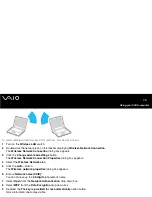
78
Using your VAIO computer
Communicating without Access Point (ad-hoc)
An ad-hoc network is a network in which a local network is created only by the wireless devices themselves, with no other central
controller or Access Point. Each device communicates directly with other devices in the network. You can set up an ad-hoc network
easily at home.
✍
In some countries, using WLAN products may be restricted by the local regulations (e.g. limited number of channels). Therefore,
before activating the WLAN functionality, read any regulatory information provided in the
Safety Information
booklet. Channel
selection is explained further in this manual (see Wireless LAN channel selection).
✍
WLAN uses the IEEE 802.11b/g standard, which specifies the technology. The standard includes the encryption method:
Wired
Equivalent Privacy
(WEP), which is a security protocol and
WiFi Protected Access
(WPA - Proposed jointly by the IEEE and Wi-
Fi Alliance, WiFi Protected Access is a specification of standards based, interoperable security enhancements that increase the
level of data protection and access control for existing WiFi networks. WPA has been designed to be forward compatible with the
IEEE 802.11i specification. It utilizes the enhanced data encryption TKIP (Temporal Key Integrity Protocol) in addition to user
authentication using 802.1X and EAP (Extensible Authentication Protocol)). Data encryption protects the vulnerable wireless link
between clients and Access Points. Besides that, there are other typical LAN security mechanisms to ensure privacy, such as:
password protection, end-to-end encryption, virtual private networks, and authentication.
✍
Wireless LAN devices using the IEEE 802.11a standard and the ones using the IEEE 802.11b or g standard cannot communicate
because the frequencies are different. Wireless LAN devices using the IEEE 802.11g standard can only communicate with a
device using the IEEE 802.11b standard, not with the IEEE 802.11a standard.
✍
IEEE 802.11b: The standard speed is 11 Mbps, or about 30 to 100 times faster than a standard dial up.
✍
IEEE 802.11g: The standard speed is 54 Mbps, or about 5 times faster than a Wireless LAN device using the IEEE 802.11b
standard.
Summary of Contents for VGN-U750P VAIO
Page 23: ...23 Using your VAIO computer ...






























